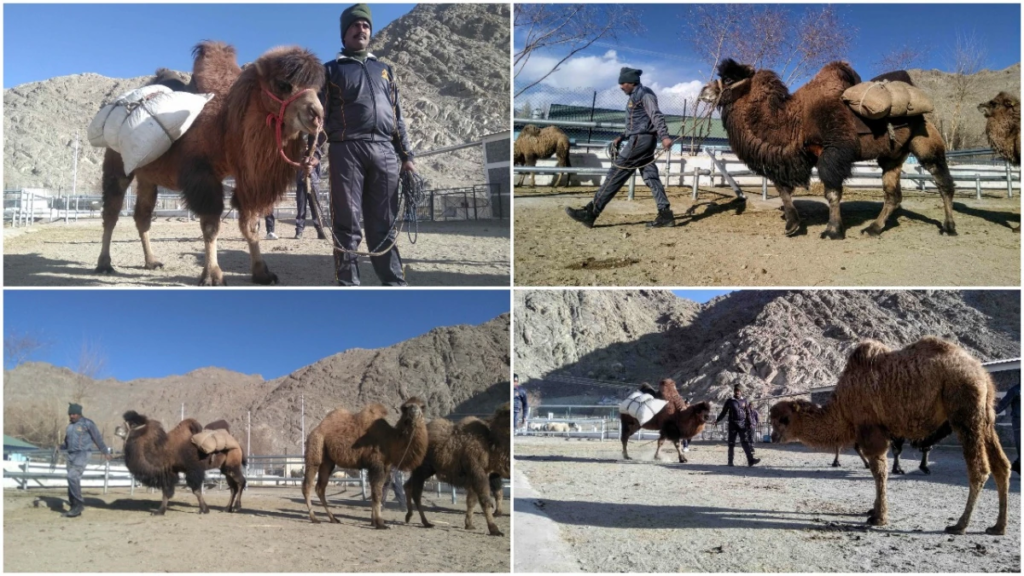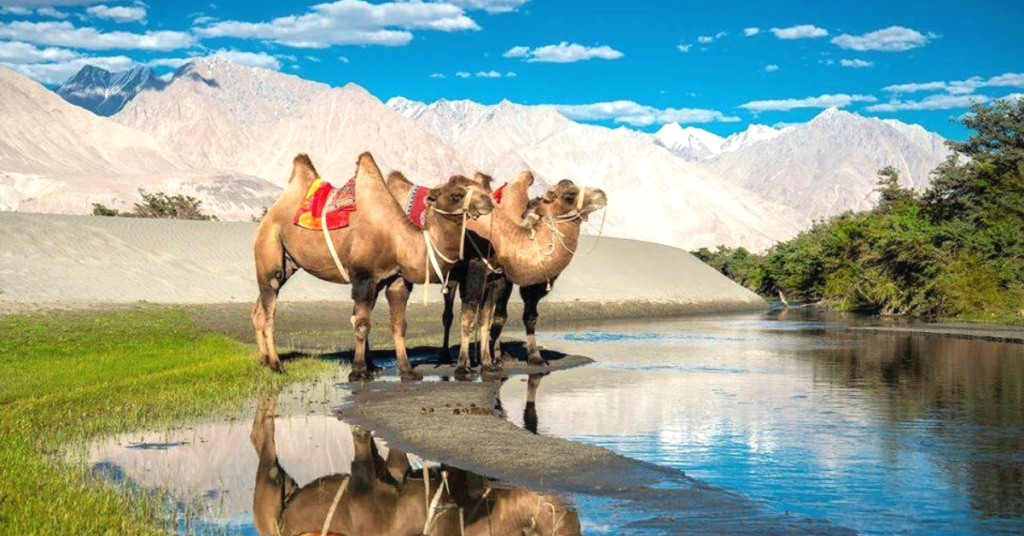In the high-altitude terrain of Ladakh, where harsh weather and logistical challenges present a significant obstacle, the Indian armed forces are turning to a natural, reliable alternative for their needs: the two-humped Bactrian camel.
Known for their resilience, strength, and ability to survive in extreme conditions, these camels are proving to be an invaluable asset in transporting equipment and patrolling the difficult landscape.
The Defence Institute of High Altitude Research (DIHAR) in Leh, Ladakh, is taking on the task of training these wild camels, reintroducing a long-lost tradition of using them as pack animals, particularly for military purposes.
The Role of Bactrian Camels in Military Logistics
Bactrian camels, or the two-humped camels, are native to Central Asia and have been used as beasts of burden for centuries, particularly on the famous Silk Road, where they carried goods across vast, rugged landscapes. What makes these camels so special is their incredible adaptability to harsh environments, such as those found in Ladakh.
Read : Top Ten Places to Enjoy Dramatic Northern Lights on Earth
They can survive in high altitudes, endure extreme cold, and go without food for up to two weeks, making them perfect for long military missions where supplies are limited.
Read : Spectacular Solar Storm Paints Ladakh’s Night Sky Crimson
The Bactrian camel’s ability to carry heavy loads—over 150 kilograms—without faltering in the cold, rarefied environment makes them particularly suited to military logistics in this region. While modern technology like drones and ATVs (all-terrain vehicles) offer potential, they are not yet reliable or effective enough in these extreme conditions.
Therefore, the Indian Army has looked to the past for solutions, using pack animals to bridge the gap in logistics, especially for last-mile connectivity in difficult terrains.
The mountains in Ladakh are notoriously challenging, with roads often blocked by snow or damaged by landslides. Even though road infrastructure has improved over the years, the final stretch of supply lines—referred to as “last-mile connectivity”—often requires the use of pack animals.
The Indian Army has long relied on Zanskar ponies in the region, particularly since the 1999 Kargil conflict. However, the Bactrian camel is emerging as an even more effective option, especially in Eastern Ladakh, where initial trials have shown promising results.

According to Colonel Ravi Kant Sharma of the Remount Veterinary Corps, training these camels to work alongside soldiers is a challenge. Unlike camels used for tourism, military camels need to remain calm and obedient in high-stress situations, including the roar of machines and gunfire.
The training process is intensive, but the results so far have been positive. These camels offer an innovative solution for the Indian Army’s logistical needs, ensuring critical supplies reach their destination, even in the most inhospitable terrains.
Advantages of Bactrian Camels in Ladakh’s Terrain
Ladakh’s geography poses a significant challenge to any form of transportation. With altitudes exceeding 15,000 feet, the lack of oxygen and extreme cold can incapacitate both humans and machines. However, Bactrian camels thrive in these conditions.
Their thick fur protects them from the cold, while their strong, sturdy bodies allow them to carry heavy loads over long distances without tiring. In comparison to modern transportation technologies like drones, which are susceptible to weather conditions and can fail due to jammers or other electronic interference, Bactrian camels offer a more reliable and time-tested solution.
The two-humped camels have unique physiological advantages that make them well-suited to the high-altitude terrain of Ladakh. They are not only adapted to survive on limited food and water, but they also store fat in their humps, which provides energy during long treks.
Furthermore, their large, flat feet make it easier for them to walk on sand, gravel, and other difficult surfaces, giving them an edge over other animals or machines in terms of mobility.
For the Indian Army, these camels represent a critical logistical tool, enabling the transportation of supplies and equipment to remote outposts. In the high-altitude deserts of Eastern Ladakh, where sandstorms are frequent and the terrain is unforgiving, the camels’ adaptability is invaluable.

During initial trials, the camels demonstrated their capacity to carry over 150 kilograms of equipment, including ammunition, food supplies, and medical kits, to forward positions. These trials have provided encouraging results, and the Indian Army is now looking to expand the use of these camels for routine operations.
In addition to their role in logistics, the camels are also being used for patrolling remote areas. In regions where vehicles cannot traverse or where enemy forces might be difficult to detect using drones, the camels offer a quiet and efficient means of patrolling.
Their presence allows soldiers to cover more ground while carrying essential equipment, ensuring that troops are well-supplied and ready for action at all times.
Impact on Local Communities and Conservation Efforts
The reintroduction of Bactrian camels into military operations in Ladakh is also having a positive impact on the local population. The training and use of these camels are providing employment opportunities for local communities, who are well-versed in the care and handling of these animals.
As the demand for camels increases, locals are being hired to help with their training and upkeep, providing a boost to the region’s economy.
Moreover, the renewed interest in Bactrian camels is contributing to conservation efforts. These camels were once widespread across Central Asia, but their numbers have dwindled over the years due to habitat loss and changes in transportation methods.
The Indian Army’s efforts to train and utilize these camels are helping to preserve this important species, ensuring their survival for future generations.
In addition to camels, the Indian Army is also exploring the use of yaks for operations at even higher altitudes. Yaks are well-suited to altitudes above 15,000 feet, where the air is thin and temperatures can drop to minus 40 degrees Celsius. Like camels, yaks have been used for centuries by local communities to transport goods across mountainous terrain.
With their larger lungs and three times the number of red blood cells compared to cattle, yaks are perfectly adapted to carry loads of up to 100 kilograms in extreme conditions.

The trials on yaks are still in the early stages, but initial results suggest that they, too, could play a vital role in military logistics in the region. As with camels, the Indian Army is working closely with local communities to train and care for these animals, ensuring that they can be integrated into operations without disrupting their natural behavior or habitat.
The Future of Pack Animals in Military Operations
As the Indian Army continues to adapt to the challenges of modern warfare, it is clear that traditional methods still have a crucial role to play. While technology will undoubtedly continue to evolve, the reliability and resilience of pack animals like Bactrian camels and yaks cannot be overstated.
In the harsh, unpredictable terrain of Ladakh, where modern machines can fail due to weather conditions or enemy interference, these animals provide a dependable alternative.
The successful trials of Bactrian camels in Eastern Ladakh have already demonstrated their value in military logistics, and their use is expected to expand in the coming years.
As more camels are trained and integrated into operations, they will become an essential part of the Indian Army’s strategy for maintaining supply lines and ensuring the mobility of troops in remote areas.
Furthermore, the Army’s efforts to involve local communities in the care and training of these animals are helping to foster a strong partnership between the military and the people of Ladakh.
By providing employment and supporting conservation efforts, the Indian Army is ensuring that the use of pack animals benefits both the military and the region as a whole.
In conclusion, the reintroduction of two-humped camels into military operations in Ladakh represents a significant step forward in addressing the logistical challenges of high-altitude warfare.
With their ability to carry heavy loads, survive in extreme conditions, and traverse difficult terrain, these camels are proving to be an invaluable asset to the Indian Army.
As trials continue and the use of these camels expands, they will undoubtedly play a crucial role in ensuring the success of military operations in one of the most challenging environments on Earth.
let’s enjoy few years on earth with peace and happiness….✍🏼🙏

